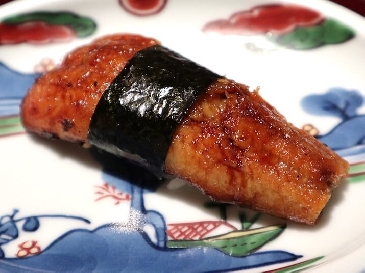Simmered


Japanese eel (Unagi)
【Nigiri sushi: Nimono】
What is Unagi (Japanese eel)?
The main characteristic that distinguishes eels from other fish species is their habit of growing in rivers and lakes and then descending to the sea to spawn. There are currently 19 species of Anguilla known in the world. However, only four species are edible: Japanese eel, European eel, American eel, and shortfin eel.
The Japanese eel is distributed in rivers and streams in the temperate zone of East Asia, including the Japanese archipelago. A team of Japanese researchers began a full-scale investigation of their ecology around 2006, and in 2009 identified their spawning grounds in the Mariana Sea area of the Pacific Ocean, more than 2,000 kilometers from Japan.
Here, the eggs hatch into transparent larvae called leptocephalus, which are 1 to 6 cm long and shaped like willow leaves. The larvae migrate through the Pacific Ocean and metamorphose into juveniles when they reach near the mouths of rivers.
What does Unagi (Japanese eel) nigiri sushi taste like?
Japanese eel has long been a delicacy enjoyed in Japan, but apparently, it has an even longer history as a dish enjoyed by ancient Greeks and Romans. The eel on the market is mostly farmed. The natural rendition is a rare find, making up less than 1% of the market. The exquisite fat melts away from the plump body, and also melts in your mouth, but without completely losing all chewiness. The combination of the sweet sauce topping and grilled aroma, as well as the acidic shari (vinegared rice), creates multiple layers of flavor and a delicious taste that is hard to describe.
Also called eel or freshwater eel.
【Related contents】
Nutritional and Functional components of unagi
List of Nimono, Gyoran and Others
(Revision date: December 29, 2023)
Main production area
Kagoshima Aichi Miyazaki Shizuoka
Famous production area
Season
Autumn-Winter (natural) Early summer (farmed)

